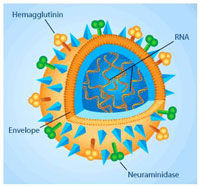Geron: First in vivo data demonstrating efficacy of GRN163L in models of primary and metastatic breast cancer
Geron Corporation announced the publication of data in Clinical Cancer Research demonstrating the broad efficacy of GRN163L, Geron's telomerase inhibitor drug, against multiple types of breast cancer cells as well as the significant reduction of metastatic activity in vivo. The research was authored by Dr. Brittney-Shea Herbert and colleagues at Indiana University Cancer Center along with Geron collaborating scientists.
The scientists initially studied the effects of GRN163L on a panel of breast cancer cells in culture to determine whether its effects might be restricted to certain tumor subtypes. Five different breast tumor cell lines representing major subtypes and varied genetic backgrounds were tested, including p53 and ER (estrogen receptor) positive and negative lines, HER2 (epidermal growth factor receptor 2) positive cells, BRCA1 mutant cells and doxorubicin-resistant cells. All tumor lines showed dramatic inhibition of telomerase when treated with GRN163L, while a mismatch control had no effect. Furthermore, GRN163L had no significant effect on viability or the rate of telomere shortening in telomerase-negative normal human mammary epithelial or endothelial progenitor cells. These results demonstrate both the specificity of GRN163L against tumor cells and its efficacy across a broad range of breast tumor subtypes.
The study results also showed that GRN163L had a more immediate effect on breast tumor lines when tested in systems designed to evaluate the ability of cancer cells to survive and migrate once detached from a tumor, replicating the natural biology of breast cancer metastasis. Using models designed to assess metastatic potential, the researchers demonstrated that GRN163L reduced colony formation by the tumor cells, reproducing an anti-adhesive effect also seen in an earlier report on the effects of GRN163L on lung cancer cells. To confirm the significance of these findings for breast tumor growth and metastasis in vivo, the researchers studied the effects of GRN163L on human tumor cells injected into the mammary fat pad of immune-compromised mice. In this model, it is possible to study the effects of drugs on growth of the primary tumor and of secondary, metastatic tumors that seed in the lung after resection of the primary tumor. GRN163L inhibited the growth of established primary tumors as compared to controls. Five of 10 mice treated with GRN163L showed no evidence of primary tumors at the end of the experiment.
In a separate study to evaluate lung metastases, mice had their established primary breast tumors removed surgically and were treated with GRN163L or saline for four weeks. The number and size of lung metastases were then judged in a blinded manner by a pathologist. The effect of GRN163L was highly significant: the metastatic index was reduced by 60% compared to the control arm (p=0.017), and the reduction of tumor nodules in the lung was visible to the naked eye. None of the GRN163L treated animals showed any evidence of treatment toxicity.
Original publication: A. E. Hochreiter, H. Xiao, E. M. Goldblatt et al.; "Telomerase template antagonist GRN163L disrupts telomere maintenance, tumor growth, and metastasis of breast cancer."; Clin Cancer Res. 2006; 12:3184-3192.
Other news from the department research and development

Get the life science industry in your inbox
By submitting this form you agree that LUMITOS AG will send you the newsletter(s) selected above by email. Your data will not be passed on to third parties. Your data will be stored and processed in accordance with our data protection regulations. LUMITOS may contact you by email for the purpose of advertising or market and opinion surveys. You can revoke your consent at any time without giving reasons to LUMITOS AG, Ernst-Augustin-Str. 2, 12489 Berlin, Germany or by e-mail at revoke@lumitos.com with effect for the future. In addition, each email contains a link to unsubscribe from the corresponding newsletter.
























































